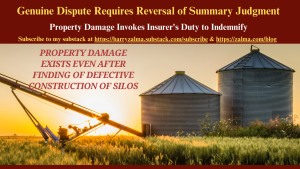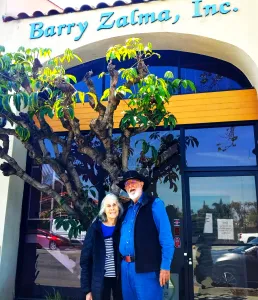Genuine Dispute Requires Reversal of Summary Judgment

Post 4898
See the full video at https://rumble.com/v5g6cgt-genuine-dispute-requires-reversal-of-summary-judgment.html and at https://youtu.be/1sdBmIg4KnY
The Fifth Circuit was asked to determine if “property damage” existed that would invoke an insurer’s obligation to indemnify under a common Commercial General Liability insurance policy had occurred. The district court determined there was no property damage under the policy, and the insurer therefore had no duty to indemnify the insured for an adverse state arbitration award.
In TIG Insurance Company v. Woodsboro Farmers Cooperative, No. 23-40435, United States Court of Appeals, Fifth Circuit (September 20, 2024) the court determined that there was property damage.
FACTUAL BACKGROUND
In March 2013, Woodsboro contracted with E.F. Erwin, Inc. to construct two Brock 105′ diameter grain silos in Woodsboro, Texas. Erwin hired subcontractor AJ Constructors, Inc. (“AJC”) to construct the silos, and Erwin was responsible for supervising the work.
Brock silos start as kits shipped from the manufacturer and are then assembled according to the manufacturer’s manuals and specifications. In short, constructing a silo is a matter of assembly. It requires putting the pieces together pursuant to the manufacturer’s instructions.
AJC began erecting the silos in May 2013 and completed its work in June or early July.
According to Woodsboro, at this time Erwin represented that the silos were ready to be used as intended. However, several defects were discovered that caused the silos to leak. Erwin attempted to repair the defects but was unable to make them watertight.
Woodsboro then contacted Buck Pitcock of Pitcock Supply, Inc., to inspect the silos. Pitcock observed numerous faults with the silos’ assembly. Pitcock attributed the damage to AJC’s “poor workmanship.” Woodsboro hired Pitcock Supply to repair the silos. When Pitcock Supply finished its work in June, Woodsboro’s total cost was $805,642.74.
In August 2014, Woodsboro sued Erwin in Texas state court for breach of contract and the case was sent to an arbitration panel. The panel found AJC had negligently constructed the silos; the silos were defective and did not conform to the construction contract and subcontract; and Erwin was unwilling or unable to repair them. The panel awarded Woodsboro a total of $988,073.25 in damages.
TIG Insurance Company (“TIG”), sued Woodsboro and Erwin and sought declaratory relief on its duty to defend and indemnify as Erwin’s insurer. The court granted TIG’s motion as to its duty to defend, finding the underlying pleadings failed to show that Erwin’s breaches resulted in “property damage” required for coverage under the policy and, even if such damage existed, several exclusions would apply.
The district court granted the remainder of TIG’s motion for summary judgment. The court concluded there was no “physical injury to tangible property” because of Erwin’s breach apart from defective construction, nor was there any “loss of use” of the silos because the arbitration panel found that Woodsboro had lost profits on account of Erwin’s late delivery of the project.
DISCUSSION
The duty to defend is governed by the eight-corners rule, that is determined solely by the facts alleged in the petition and the terms of the policy. The duty to indemnify, on the other hand, is determined by the actual facts establishing liability in the underlying suit, and therefore generally cannot be ascertained until the completion of litigation.
Once Woodsboro filed a petition for breach of contract, there existed a potential claim for coverage sufficient to constitute a case or controversy and confer standing on TIG as Erwin’s insurer.
The Fifth Circuit concluded that the district court did not err in “defer[ring] resolution of indemnity issues until the liability litigation [was] resolved” and a final judgment was entered.
TIG’s Motion For Summary Judgment
TIG may have a duty to indemnify. Erwin holds a standard Commercial General Liability (“CGL”) insurance policy. Under Texas law, “physical injury” to tangible property requires tangible, manifest harm and does not result merely upon the installation of a defective component in a product or system. The district court determined Erwin’s role was more akin to defective installation requiring repair than defective work which caused physical damage to other property.
Based on testimony and evidence, the panel found the silo bins as originally constructed by AJC, were defective. Although the district court’s interpretation might be reasonable on the face of the arbitration decision, it failed to make all inferences in Woodsboro’s favor as the nonmoving party. Pitcock observed degradation to the rest of the structure.
The record reveals at least some evidence of wind and weather damage during the policy period. Satisfied that the evidence, when viewed in the light most favorable to Woodsboro, supports the determination that “property damage” occurred, the Fifth Circuit looked at the exclusions.
There is evidence suggesting that sometime between AJC’s exit from the project and Pitcock’s assessment in May 2014, wind and weather damaged the silos. Thus, damage from the wind and weather could have occurred after AJC’s “active performance of work.”
The Fifth Circuit concluded that a genuine dispute of material facts existed making the district court’s grant of summary judgment improper. Physical injury can be inferred from the arbitration panel’s findings and the evidence, but that is inappropriate at this stage so the district court’s judgment was reversed.
Property damage was seen to have occurred after all work was done on the silos before they were replaced. Since wind may have caused damage to the defectively built silos there was evidence of property damage and raised a potential for the existence of coverage to indemnify the insured who improperly and defectively constructed the silos.
 (c) 2024 Barry Zalma & ClaimSchool, Inc.
(c) 2024 Barry Zalma & ClaimSchool, Inc.
Please tell your friends and colleagues about this blog and the videos and let them subscribe to the blog and the videos.
Subscribe to my substack at https://barryzalma.substack.com/subscribe
Go to X @bzalma; Go to Newsbreak.com https://www.newsbreak.com/@c/1653419?s=01; Go to Barry Zalma videos at Rumble.com at https://rumble.com/account/content?type=all; Go to Barry Zalma on YouTube- https://www.youtube.com/channel/UCysiZklEtxZsSF9DfC0Expg
Go to the Insurance Claims Library – https://lnkd.in/gwEYk
Like this:
Loading…







